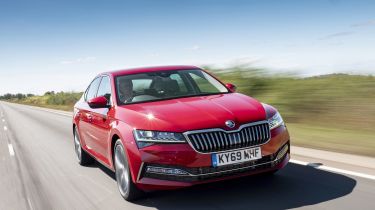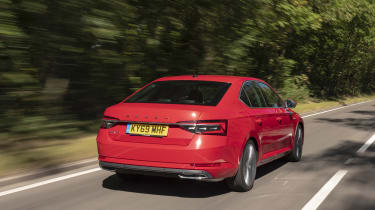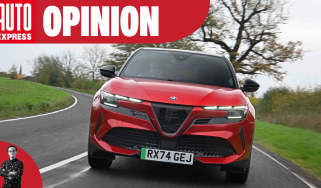Skoda Superb (2015-2024) - Engines, performance and drive
The Superb is a refined and comfortable cruiser, but don't expect sporty dynamics

Just to let you know, this is an older review of the 2015-2024 Skoda Superb. If you are interested in information about the engines in the latest Skoda Superb, or news of upcoming Skoda models, please follow the links provided.
The Superb’s mission is to be an executive limousine for the masses, so the focus is firmly on comfort and refinement ahead of pin-sharp driving dynamics. And whether you’re wafting around town or cruising quietly along the motorway, it’s clear that Skoda has done a great job.
Refinement is noticeably better than its predecessor, especially with the quieter petrol engines under the bonnet, making it a relaxing way to cover big miles. Four-wheel-drive versions grip harder when the weather turns nasty, but front-wheel-drive models feel just as planted the rest of the time.
Adaptive dampers are an option on SE cars and above, or standard on Laurin & Klement cars. They offer a dramatic effect on the Superb’s behaviour as you toggle through the three settings – Comfort, Normal and Sport.
In Comfort it floats over crests and dips, while the nose has a tendency to bob, and body control is too slack for fast cornering. Sport tightens everything up, but feels a bit too brittle on poor surfaces and with the larger wheels fitted to top-spec cars. Normal mode, then, is the best compromise for everyday driving.
Used - available now

2023 Skoda
Superb
82,400 milesManualDiesel2.0L
Cash £11,508
2023 Skoda
Superb
40,747 milesManualDiesel2.0L
Cash £14,724
2024 Skoda
Superb
68,914 milesAutomaticPetrol1.5L
Cash £13,821
2024 Skoda
Superb
15,136 milesAutomaticPetrol2.0L
Cash £23,950If you want to save money then the manual gearbox is perfectly adequate, but we’d recommend stretching to the DSG auto that adds another layer of sophistication to the driving experience and suits the Superb’s laid-back character.
Go for a SportLine Plus model, and while the 19-inch alloys and subtly dropped ride height give the Skoda plenty of appeal, they do affect the ride quality slightly. It lacks the same absorbent edge as the standard Superb on the road, but the ride could never be considered uncomfortable. The optional Dynamic Chassis Control adaptive dampers help negate this a little when in Comfort mode.
The trade-off is that the Skoda is more direct on twisting country routes. The steering is sharper and less spongy than in some rivals, while there’s marginally more grip, too, because the Superb controls roll better.
Engines, 0-60 acceleration and top speed
The Superb’s engine range was revised in 2019, with petrol and diesel models still on offer to suit most buyers. The four-cylinder, 1.5-litre TSI petrol produces 148bhp and is available on SE models and above, mated to a six-speed manual or seven-speed DSG automatic gearbox. A 2.0-litre four-cylinder engine is also offered, producing 187bhp and available exclusively with a DSG gearbox.
The most powerful engine available is a 2.0-litre TSI petrol with 276bhp – enough for a 5.3-second sprint to 62mph in the hatch or 5.3 seconds in the estate. It’s an engine best enjoyed with the optional adaptive dampers, but even in conventionally sprung cars is fast and agile enough to keep up with some much sportier machinery.
Customers looking to the 1.4 TSI iV plug-in hybrid will benefit from a combination of a 1.4-litre four-cylinder petrol engine and a 113bhp electric motor, producing a total of 215bhp. In addition to the increased efficiencies on offer, the iV model brings decent performance, managing the 0-62mph dash in 7.7 seconds.
Diesel power is represented by a 2.0-litre unit offering outputs of either 148bhp or 197bhp, with the former needing 9.1 seconds to complete the 0-62mph run, and the latter just 7.3 seconds with the addition of four-wheel-drive.




